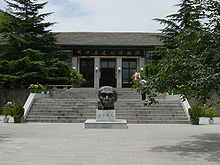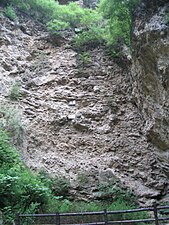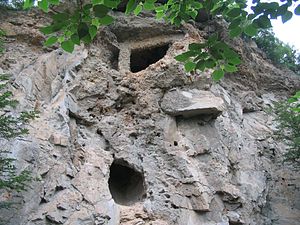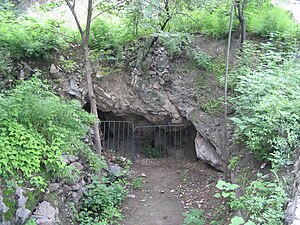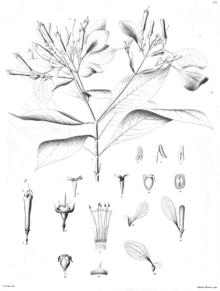저우커우뎬
Zhoukoudian| 유네스코 세계유산 | |||||||||||
|---|---|---|---|---|---|---|---|---|---|---|---|
 저우커우뎬 입구 | |||||||||||
| 공식 명칭 | 저우커우뎬 북경인 유적지 | ||||||||||
| 위치 | 중국 베이징 팡산 구 저우커우뎬 진 | ||||||||||
| 기준 | 문화: (iii), (ii) | ||||||||||
| 언급 | 449 | ||||||||||
| 비문 | 1987년(11차 세션) | ||||||||||
| 지역 | 480 ha (1.9 평방 mi) | ||||||||||
| 버퍼 존 | 888 ha (3.43 평방 mi) | ||||||||||
| 좌표 | 39°41°21°N 115°55~26°E/39.68917°N 115.92389°E좌표: 39°41°21°N 115°55°26°E / 39.68917°N 115.92389°E/ | ||||||||||
| 한자이름 | |||||||||||
| 간체자 중국어 | 周口店北京人遗址 | ||||||||||
| |||||||||||
저우커우톈(周口天) 북경인(北京人)은 베이징 팡산(方山)구 교외에 있는 동굴 시스템이다.그것은 베이징 맨이라고 불리는 호모 에렉투스(Homo erectus pekinensis)의 첫 표본 중 하나와 거대한 하이에나 파키크로커타 브레비이로스트리스의 훌륭한 뼈 집합체를 포함한 많은 고고학적 발견을 가져왔다.
증거에 대한 다른 해석으로 인해, 북경인이 이 유적지에 거주한 시기는 70만-200,000년 [1]전, 67만-470,000년 [2]전, 또는 53만 [3]년 이전 등 매우 다양하다.
1921년 [4]요한 군나르 안데르손에 의해 처음 발견됐고 1921년과 1923년 오토 즈단스키에 의해 두 사람의 [5]이빨이 발굴됐다.이것들은 나중에 데이비드슨 블랙에 의해 이전에 알려지지 않았던 종에 속하는 것으로 확인되었고, 광범위한 발굴이 뒤따랐다.석회석이 함유된 중기의 플라이스토세 퇴적물에 있는 균열은 동물의 유해뿐만 아니라 약 45명의 유골과 돌 조각과 절단 도구를 산출했다.
가장 오래된 동물의 유적은 69만년 전으로 거슬러 올라가며, 도구들은 67만년 [6]전으로 거슬러 올라가는 반면, 또 다른 당국은 발견된 도구들의 연대를 53만년 [3]이전으로 추정한다.후기 구석기 시대에는 이 유적지가 다시 점령되었고, 상부 동굴에서 호모 사피엔스와 그들의 석골 도구들도 발견되었다.
소행성 243 아이다에 있는 분화구 Choukoutien은 그 장소의 이름을 따서 명명되었다.이 동굴들은 베이징 중심부의 남서쪽에 위치한 팡산 구의 저우커우뎬 타운에 위치해 있다.
발굴 이력
검출
여기 원시인이 있어요. 이제 우리가 해야 할 일은 그를 찾는 거예요!
--
스웨덴의 지질학자 요한 군나르 안데르손 처음으로 1918년의 한 지역 Chicken-bone 힐았지만 1921년까지 그는 미국 고생물 학자 월터 W. 그레인저 역을 맡은 사이트 드래곤 뼈 힐로 알려지도록 하여 졌다 것이 아니다 풍부하게 there,[7]에서 발견되는 설치류 화석들 잘못된 지목했다 내국인들에 의해에서 그 지역의 자신의 탐험을 시작했다.lo칼 채석공이 지역에 이질적인 백색 석영을 발견하고 그는 바로 이곳이 원시인의 [8]유골을 찾기 좋은 장소라는 것을 깨달았다.
발굴은 1921년과 1923년에 안데르손의 조수인 오스트리아 고생물학자 오토 즈단스키에 의해 이루어졌고, 더 많은 분석을 위해 스웨덴의 웁살라 대학으로 보내진 많은 자료들을 찾아냈다.1926년 앤더슨은 이 물질들 중 두 개의 어금니를 발견했다고 발표했고, 그 다음 해에 Zdansky는 조심스럽게 치아를 식별하면서 그의 발견을 발표했습니다.Homo sp.[9]
때때로 저우키다늑대로 불리는 카니스 변종 화석은 1934년 저우커우디안 동굴 시스템과 고고학 유적지에서 발견되었으며 발견자인 페이원중(Pei Wenzhong)에 의해 이름이 붙여졌다.
위에서 설명한 개과 진성 낭창 사이에 뚜렷한 선을 추적할 수는 없지만 크기와 두개골 특징에서 발견된 현저한 차이는 저우커우드의 국소 1번 [citation needed]작은 늑대를 위해 적어도 새로운 품종인 개과 낭창 변종(Canis lupus variabilis)을 만들기에 충분할 것으로 보인다.
저우커우뎬 계획
당시 북경유니온 의과대학에서 일하던 캐나다 고생인류학자 데이비드슨 블랙은 앤더슨과 즈단스키의 발견에 흥분해 록펠러 재단에 유적지를 체계적으로 발굴하기 위한 자금 지원을 신청했다.자금 지원이 이루어졌고, 1927년 중국 고고학자 리제(李 funding)의 감독 하에 저우커우뎬(周口天) 프로젝트가 발굴을 시작했다.
그 해 가을, 스웨덴의 고생물학자 안데르스 비거 볼린에 의해 이빨이 발굴되었는데, 블랙은 이 이빨이 시난트로푸스 [10]페키넨시스라고 불리는 새로운 종에 속한다고 제안했다.다음 해, 블랙의 발굴은 이빨, 어린 턱의 상당 부분, 그리고 이빨 [11]세 개가 있는 성인 턱을 포함한 그의 새로운 종의 더 많은 화석을 발견했다.이러한 발견으로 블랙은 연구소를 설립하기 위해 재단에서 추가로 8만 달러의 보조금을 받을 수 있었다.
신생대 연구소
중국 지질조사 신생대 연구소는 1928년 중국 지질학자 딩원장(鄭文江)과 웅원하오(,文hao)의 도움을 받아 베이징유니온 의과대학에 설립돼 발굴된 화석에 대한 조사와 감정 작업을 벌였다.블랙은 중국 고생물학자 양중젠, 인류학자 페이원중, 자란포 등의 발굴 작업을 계속하는 동안 명예 소장으로 연구소에 머물렀다.
과학자들은 노새를 타고 발굴에 나섰고 도중에 캐러밴서리에 머물러야 하는 등 현장의 상황은 원시적이었다.1929년 발굴 당시 40m의 균열에서 한 손에는 망치를, 다른 [12]손에는 촛불을 들고 작업하던 페이가 직접 만들었다.1930년에 [13]두 번째 해골모자가 발견되었고 1932년까지 거의 100명의 근로자들이 매일 [14]현장에 배치되었다.
현장의 여건에도 불구하고 저명한 연구자들의 발길이 끊이지 않았다.프랑스 고생물학자 피에르 테일하르 드 샤르댕은 1926년부터 이곳을 단골로 방문했다.1931년 프랑스 고고학자 앙리 브로일이 방문해 석기의 존재를 확인했다.같은 해, 동굴에서 불을 사용했다는 증거가 [15]받아들여졌다.
항상 근면했던 흑인은 1934년 어느 날 밤 자신의 사무실에서 사망했는데, 그 자리에서 발견된 해골 모자 중 하나가 그의 [16]책상 위에 있었다.독일 유대인 인류학자 프란츠 바이덴라이히는 그를 대신해 연구소의 명예 소장이 되었고, 발굴은 계속되어 1936년에 [17]세 개의 두개골 캡을 추가로 발견했다.
1937년 일본의 중국 침략에 의해 정지되기 전까지 발굴을 통해 거의 완전한 해골캡 [18]5개를 포함한 40여 명의 인간 화석 200여 점이 발견되었다.일본의 만행에 대한 보고에는 현장에서 일하는 노동자들을 고문하고 살해했으며, 세 명은 총검에 찔려 죽었고, 네 번째는 [19]굶어 죽을 때까지 인력거를 끌어야 했다.
1941년,[20] 대부분의 발견물이 안전지대로 이송되는 동안 분실되어 다시는 회수되지 않았다.다행히 바이덴라이크는 화석의 물리적 [21]특성을 보존하기 위해 복제품을 만들었다.
전후 발굴
발굴 작업은 1949년에 재개되어 5개의 이빨과 허벅지,[22] 정강이뼈 파편 등 새로운 북경인 화석을 발굴했다.이듬해 1921년과 [23]1923년 즈단스키에 의해 웁살라로 보내진 물질에서 세 번째 전극이 발견되었다.
북경인유적은 1959년 [24]중국 전국성층학위원회 연차총회에서 중국 중기의 갱년기 동굴 퇴적물 유형으로 지정돼 하악골 파편이 [25]발굴됐다.
1966년 페이가 주도한 발굴에서 전극과 두 개의 두개골 조각이 발견되었는데, 이것들은 1934년과 1936년 이전 발굴에서 보존된 조각들과 일치하며, 거의 완전한 두개골 모자의 현존하는 유일한 예가 함께 [26]조각되었다.
1972년부터 73년까지 저우커우디안 지역 4번지 발굴에서 호모 사피엔스 [27]전극이 발굴되었다.
현대의 과학적 연대 측정 기술은 이 유적지가 23만 년에서 50만 년 전에 [28]사용되었음을 확인시켜 준다.
발굴 현장
북경인 사이트
북경 남성 유적지로도 알려진 지역 1은 1921년 지역 채석업자들의 지시로 처음 발견되었다.그 장소는 원래 천연 석회암 동굴이었지만, 지붕이 무너진 지 오래되었고, 퇴적물 꼭대기에 벽돌 층과 파편들이 퍼져 있었다.1921년과 1923년의 초기 발굴은 20만년에서 50만년 전에 사람이 살았다는 증거를 보여주었다.이 동굴은 1927-37년에 발굴되어 호모 에렉투스로 확인된 200개의 인간 화석, 10,000개 이상의 석기 조각, 초기 인류에 불이 사용되었음을 나타내는 여러 개의 신더 층, 그리고 200여 종의 동물 화석이 발견되었다.이 재료의 대부분은 일제 강점기인 1941년에 유실되어 지금까지 회수된 적이 없다. 일본 점령1949년에 발굴이 재개되어 화석과 유물을 계속 생산하고 있어, 이 유적지는 중기의 플라이스토세 시대의 [29][30][31]가장 생산적인 물질 공급원 중 하나가 되었다.
총 13단이 발굴되었으며 깊이는 40m에 육박한다.
| 층 | 두꺼운 | 일관성. | 찾는다 |
|---|---|---|---|
| 1-2 | 4m | 브레치아와 트라베르틴 | 화석 및 석기 |
| 3 | 3m | 지붕 붕괴로 형성된 코스 브레치아 및 석회암 블록 | 북경인의 두개골(1966년), 화석 및 석기 |
| 4 | 6m | 재와 석회암 블록 | 화골·석기·화석·석기류 상부문화구역 |
| 5 | 1m | 래그스톤 | 화석 및 석기 |
| 6 | 5m | 브레치아, 석회암 블록 및 하이에나 똥 | 화석 및 석기 |
| 7 | 2m | 모래 | 화석 및 석기 |
| 8-9 | 6m | 브레치아 & 애쉬 | 북경인 화석이 대부분 발견된 로어 컬처 |
| 10 | 2m | 라테라이트 및 재 | 화석 및 석기 |
| 11 | 2m | 브레치아 | 최초의 북경인 두개골(1929년), 화석 및 석기 |
| 12 | 2m | 붉은 모래 | 화석 |
| 13 | 2m | 실트 하이에나똥 | 화석 및 석기 |
이 아래의 층은 화석이나 석기를 포함하지 않는 시험용 시추로 밝혀졌으며 [32]발굴된 적은 없다.
이스트 슬로프이 경사면은 1930-58년, 1978-79년 다학문 연구 임무에서 발굴되었다.발굴작업은 3~6층까지 7m 깊이로 파고 석기, 불에 탄 뼈와 재, 조류, 파충류,[33] 포유류의 화석 등을 발굴했다. | 비둘기 홀비둘기관은 조류 탐방객이 많은 것을 기념하여 붙여진 이름이며 1928년 일꾼들에 의해 북경인유적과 연결되었다.1930년부터 1931년까지의 발굴에서 수많은 북경인의 뼈(하악골, 쇄골, 두정골 포함), 불에 탄 흔적(붉은 봉오리 포함), 석영 석기, 녹색 사암 [34]등이 발굴되었다. |
상부 동굴
용골언덕 상부에 위치한 이 동굴은 1930년 발견돼 1933~34년 발굴된 뒤 지붕과 북향 개구부를 없앴다.발굴 결과 1만년에서 2만년 전 동굴에서 사람이 살았다는 증거가 발견됐다.동굴은 위층 거주지와 아래층 매장지로 나뉘었고, 아래층의 작은 움푹 패인 곳은 천연동물의 [35]덫 역할을 했다.발굴된 유물에는 3개의 인간 두개골과 고대 호모 사피엔스로 확인된 최소 8명의 다른 유골, 돌과 뼈로 만들어진 도구와 장식품, 그리고 하층 [36]덫에 걸린 대형 포유류의 완전한 뼈를 포함한 수많은 동물 뼈들이 포함되어 있다.또한 아래층 유골에 흰 가루가 뿌려져 있어 주민들이 장례를 [37]치렀다는 것을 알 수 있다.
기타 지역
저우커우뎬에서는 지금까지 20개 이상의 화석이 발굴되었다.
지역 2이 남북으로 흐르는 균열은 붉은 결합 토양으로 채워져 있으며, 중기의 플라이스토세 시대로 거슬러 올라갑니다.1921년 북경인유적 발굴과 동시에 햄스터, 코뿔소, [38]중국 하이에나 등 포유동물 화석이 발굴됐다. 지역 31927년에 발견된 이 동서간 균열은 브레치아로 가득 차 있으며, 중세 플라이스토세 시대로 거슬러 올라간다.1933년 발굴로 고슴도치, 너구리,[39] 오소리 등 포유류 화석이 발굴됐다. 지역 41927년에 발견된 이 남북으로 흐르는 균열은 황사토 점토로 채워져 있으며, 중기의 플라이스토세 시대로 거슬러 올라간다.1937년부터 38년까지의 발굴로 석기, 불에 탄 뼈와 씨앗(초기 인류에서의 화재 사용을 나타냄), 자칼과 사슴의 화석이 발굴되었다.1973년 두 번째 발굴로 인간의 전극과 마카크, 돼지, 곰, 말 [40]등 40종의 포유동물 화석들이 발굴됐다. 상한 예금강바닥 60m 위에 위치한 이 퇴적물은 모래와 자갈로 채워져 있으며 초기 플리오센 시대로 거슬러 올라간다.1937년부터 1938년까지의 발굴로 사향고양이와 대나무 [41]쥐를 포함한 포유류의 화석이 발굴되었다. 새 동굴1967년에 발견된 이 동굴은 남쪽으로 Locality 4와 연결되어 있다.고여 있는 물 조건에서의 정수 침전에 의해 형성된 퇴적물에는 화석이나 인간 관련 [42]유물이 포함되어 있지 않았다. | 지역 121933년 국부 3호 발굴 당시 발견된 이 기둥 모양의 부식구덩이는 붉은 모래로 채워져 있으며, 플라이스토세 전기로 거슬러 올라간다.발굴을 통해 사브르 이빨 호랑이와 멸종한 [43]영장류 등 22종의 포유동물 화석이 발굴됐다. 장소 13베이징 남성 유적에서 남쪽으로 1km 떨어진 석회암 언덕에 있는 이 균열은 플라이스토세 초기로 거슬러 올라가며 저우커우뎬에서 지금까지 발굴된 가장 이른 문화 유적지이다.강바닥 약 50m 상공의 얇은 모래흙을 발굴한 결과 돌 공예품과 화산재, 새까맣게 탄 뼈, 굵은턱 거대사슴, 사브르 이빨 [44]호랑이 등 깊이 화석화된 포유류 뼈 36종이 발견됐다. 장소 14이 좁은 석회암 동굴은 베이징 남성 유적에서 남쪽으로 1.5km(0.93mi) 떨어진 플리오센 시대로 거슬러 올라가며, 5백만 년 전으로 거슬러 올라가는 저우커우디안의 가장 오래된 화석들 중 일부를 발굴했다.1933년, 1951년, 1953년 강바닥 약 70m 위의 얇은 층의 고운 사암을 발굴하면서 4종류의 거의 완전한 물고기 화석이 600개 이상 발굴되었고, 그 중 2종은 [45]멸종되었다. 지역 151932년에 발견된 이 비교적 젊은 유적은 약 10만 년에서 20만 년 전으로 거슬러 올라간다.1934년부터 35년까지 발굴을 통해 황토와 석회암 파편의 상층, 화산재, 석기, 불에 탄 뼈와 핵베리 씨앗을 포함한 중간층, 그리고 석기를 포함한 황토와 양털 코뿔소, 거대 사슴, 가젤을 포함한 조류와 포유류의 화석을 발견했다.그 장소는 아직 완전히 [46]발굴되지 않았다. |
갤러리
「 」를 참조해 주세요.
- 화석 유적 목록 (링크 디렉토리 포함)
- 인류 화석 목록 (이미지 포함)
- 중국의 제4기 포유동물 목록
- 중국의 세계유산
- 북경인
레퍼런스
- ^ UNESCO 세계문화유산: 저우커우뎬 북경인유적(https://whc.unesco.org/en/list/449)이 2013년 12월 15일 취득
- ^ 중국 저우커우뎬 북경만 동굴의 퇴적물 분석에 의해 기후 사이클이 조사되었다.저우, C, Lui, Z., 왕, Y.; 고고학 저널 27, 2000, 페이지 101-109.
- ^ a b 선사백과사전 제3권 동아시아 및 오세아니아, 천근호, 인간관계영역파일, 주식회사, 2001, 페이지 352.
- ^ "The First Knock at the Door". Peking Man Site Museum.
In the summer of 1921, Dr. J.G. Andersson and his companions discovered this richly fossiliferous deposit through the local quarry men's guide. During examination he was surprised to notice some fragments of white quartz in tabus, a mineral normally foreign in that locality. The significance of this occurrence immediately suggested itself to him and turning to his companions, he exclaimed dramatically "Here is primitive man, now all we have to do is find him!"
- ^ "The First Knock at the Door". Peking Man Site Museum.
For some weeks in this summer and a longer period in 1923 Dr. Otto Zdansky carried on excavations of this cave site. He accumulated an extensive collection of fossil material, including two Homo erectus teeth that were recognized in 1926. So, the cave home of Peking Man was opened to the world.
- ^ "초식동물 치아 에나멜의 탄소 및 산소 동위원소 기록에서 중국 저우커우뎬의 중기 플라이스토세 기후 및 서식지 변화", Gaboardia, Deng and Wang, 제4기 연구 63, 2005, 페이지 331
- ^ "The Peking Man World Heritage Site at Zhoukoudian". UNESCO. Retrieved 2008-04-20.
In February 1918, Johann Gunnar Andersson, a famous Swedish geologist and archaeologist, was told that there were some fossils at what was called Chicken-bone Hill near Zhoukoudian. He was then serving as an adviser on mineral affairs in the Ministry of Agriculture and Commerce of the Chinese Government. He showed much interest and, in the following month, made a survey at the hill where a lot of rodent fossil was collected. The rodent fossil was taken as chicken bones by local people and the Chicken-bone Hill was so named. The latter is nominated later as Locality 6 of the Peking Man Site. This discovery of the locality is not so important, but the survey led to a series of investigations in the region.
- ^ "Review of the History". Peking Man Site Museum.
John Gunnar Anderson, a Swedish geologist, discovered Peking Man Site in 1921. Under his supervision, Otto Zdensky, an Austrian palaeontologist, excavated at the site in 1921 and 1923 and found a human molar.
- ^ "Review of the History". Peking Man Site Museum.
In 1926 a human premolar was found among the material from the Peking Man Site during preparation in the laboratory in Uppsala, Sweden. Andersson announced the discovery in October in Beijing.
- ^ "Review of the History". Peking Man Site Museum.
Under support of Rockefeller Foundation, the excavation at Zhoukoudian started on a large scale in 1927. A well-preserved human molar was found. Davidson Black proposed a new genus and a new species, Sinathropus pekinensis, for the human teeth found at Peking Man Site.
- ^ "Review of the History". Peking Man Site Museum.
During the field season of 1928, numerous isolated teeth, the greater part of a juvenile jaw and an adult jaw fragment with three molars were discovered.
- ^ Melvin, Sheila (October 11, 2005). "Archaeology: Peking Man, still missing and missed". International Herald Tribune. Retrieved 2008-04-20.
The scientists who worked on the excavation rode to the site on mules and stayed in an old caravansary. The first skullcap was dug out by Pei Wenzhong working in a 40-meter crevasse in frigid weather with a hammer in one hand and a candle in the other.
- ^ "The Peking Man World Heritage Site at Zhoukoudian". UNESCO. Retrieved 2008-04-20.
Just after the discovery of the first skullcap of Peking Man, the second skullcap was discovered in the spring of 1930. It was found and restored from a block of sediments from locus nearby that of the first skullcap and brought back to the Cenozoic Research Laboratory.
- ^ "The Peking Man World Heritage Site at Zhoukoudian". UNESCO. Retrieved 2008-04-20.
In 1932, the scale of the excavation was large and daily employment of workers was more than one hundred. Within a square kilometre sphere, excavation of different loci was often carried out simultaneously.
- ^ "Review of the History". Peking Man Site Museum.
Henri Breuil, a French archaeologist, was invited to visit the site in 1931, he confirmed the existence of stone tools at Peking Man Site. In the same year, the evidence of the use of fire at this cave was accepted by the anthropological circle.
- ^ Melvin, Sheila (October 11, 2005). "Archaeology: Peking Man, still missing and missed". International Herald Tribune. Archived from the original on 2005-10-12. Retrieved 2022-04-26.
Black died at his office desk in the middle of the night with a skullcap of Peking Man beside him.
- ^ "The Peking Man World Heritage Site at Zhoukoudian". UNESCO. Retrieved 2008-04-20.
Since 1935, excavation was under the charge of Mr. Jia Lan-po, world famous archeologist. In the following excavations, the most fruitful year was in 1936, three complete skullcaps were unearthed.
- ^ "Review of the History". Peking Man Site Museum.
During 1927-1937, abundant human and animal fossils as well as artefact were found at Peking Man Site, it made the site to be the most productive one of the Homo erectus sites of the same age all over the world. Other localities in the vicinity were also excavated almost at the same time.
- ^ Melvin, Sheila (October 11, 2005). "Archaeology: Peking Man, still missing and missed". International Herald Tribune. Archived from the original on 2005-10-12. Retrieved 2022-04-26.
Three Chinese workers at the site were tortured and then bayoneted to death by Japanese soldiers, and one worker was forced to drive a rickshaw and died of starvation.
- ^ "Review of the History". Peking Man Site Museum.
During World War II, Peking Man fossils were lost in 1941.
- ^ "Review of the History". Peking Man Site Museum.
But the fossils had been studied in great detail by Franz Weidenreich, a German Jewish anthropologist, whose publication on Peking Man provided most part of the knowledge of the physical characters of the earliest humans known by then.
- ^ "Review of the History". Peking Man Site Museum.
The excavation work at Zhoukoudian site was resumed in 1949, 5 teeth and one piece of thighbone fragment as well as one piece of shinbone fragment of Peking Man were found.
- ^ "Review of the History". Peking Man Site Museum.
In 1950, another premolar was found in the materials unearthed from the Peking Man Site, the materials were transported to Uppsala in the early 1920s.
- ^ "Review of the History". Peking Man Site Museum.
Peking Man Site was designated as the type section of cave deposits of Middle Pleistocene in North China on the Annual Congress of National Committee of Stratigraphy of China in 1959.
- ^ "Review of the History". Peking Man Site Museum.
A mandibular fragment of Peking Man was found in 1959.
- ^ "Review of the History". Peking Man Site Museum.
Two pieces of cranial fragment and a premolar of Peking Man were found in 1966, these two skull fragment perfectly matched with the two pieces of skull fragment unearthed in 1934 (one of which was recognized in laboratory in 1936), they belong to the same individual.
- ^ "Review of the History". Peking Man Site Museum.
A premolar of Homo sapiens was found at Locality 4 of Zhoukoudian during 1972-1973.
- ^ Wendy Conklin. "Mysteries in History: World History". Peking Man Site Museum.
Each set belonged to a different Peking man. They were more than 500,000 years old. With these bones, scientists were able to figure out what this Peking Man looked like.
- ^ "Peking Man Site". Peking Man Site Museum.
Peking Man Site, or the Locality 1, at Zhoukoudian, was originally a natural limestone cave. The Peking Man, from about fix or six hundred thousand years ago, claimed here as their home. They lived Zhoukoudian discontinuously until about 200,000 years ago, and their remains, relics as well as the rock off from the cave roof and bedload from outside the cave deposited in the cave layer by layer. Eventually, thick deposits have come into being, which are some 140 meters long from the east to west, 2m to 40m wide from south to north, 40-plus meters thick, and composed of 13 layers.
- ^ "Peking Man Site". Peking Man Site Museum.
Discovered in 1921, this site had been excavated systematically from 1927 to 1937 when the July 7th Incident of 1937 broke out. The excavation restored after liberation. Over the past decades, the middle section (about 27,000m³) of the deposit was excavated, from which nearly 200 human fossils (belong to 40 ape men), more than 10,000 pieces of stoneware, several cinder layers as well as animal fossils of almost 200 species have been discovered. Compared to other sites of the same era in the world, Peking Man Site boasts the most integral and richest findings and is the best representative of all ape-man sites, therefore playing an important and irreplaceable role in the scientific research and human being’s ancient culture history.
- ^ "Peking Man Site". Peking Man Site Museum.
Before excavation, the roof of the cave had already collapsed, which became the breccia and rocks on the top of the deposits. In the process of digging, all holes were dug out except for the Pigeon Hole in the east, which was cemented too hard to be removed.
- ^ "Description of the profile". Peking Man Site Museum.
Layers 1-2: Breccia containing travertine, about 4m thick. Layer 3: Coarse breccia, containing huge limestone blocks, formed by the roof collapse. A skull of Peking Man was found from this layer in 1966. Layer 4: Laminated ashy layer (Upper Cultural Zone) containing burned bones and stones, as well as huge limestone blocks, about 6m thick. Layer 5: Stalagmite layer, about 1m thick. Layer 6: Breccia, containing huge limestone blocks and hyena coprolites, about 5m thick. Layer 7: Sandy layer, about 2m thick. Layers 8-9: Breccia containing ash (Lower Cultural Zone), about half of Peking Man fossil assemblage was found from the layers, about 6m thick. Layer 10: Reddish clay (upper part) and ash (lower part), about 2m thick. Layer 11: Breccia. The first skull of Peking Man was found from the layer corresponding to this one in 1929, about 2m thick. Layer 12: Reddish sandy layer about, 2m thick. Layer 13: Sand and clay containing boulders and hyena coprolites, about 2m thick. All of the layers mentioned above contain fossils and contain stone artefacts except Layer 12. The deposit under the 13th layer was not excavated and only known from the test pit without fossil and stone artefact.
- ^ "The excavated area of The east slope". Peking Man Site Museum.
The East Slope is one part of Peking Man site, and it once was excavated during 1930-1958. The most recent excavation was conducted during the mission (1978–1979) of the multi-disciplinary synthetic researches at the site. The excavate area is 20 meters long, 16 meters wide from north to south, and 7 meters deep; approximately 320 square meters of surface. In stratigraphy, the excavated part can be correlated with the layers 3-6, among which the 4th layer is the ash-layer and the other layers are composed of well cemented breccias. The animal fossils recovered include mammals, reptiles and birds. Some stone tools, burned bones and ashes left by humans were also unearthed.
- ^ "Pigeon Hall". Peking Man Site Museum.
Pigeon Hall was named for its frequent visit by pigeons. The northern wall is made of limestone. Two holes were made on the east side of the wall for the purpose of collecting stones and burnt limes. The cave roof and southern wall contain petrous breccia with fossils. In 1928, when the Locality 1 was being excavated, workers connected the west end of the cave with Locality 1. It was excavated in 1930 and 1931 respectively. The most important finding here include fossils of clavicles, parietal bones, mandibles of ape-men, and many primary stone tools made of quartz and green sandstones. The four culture layers include the signs of ape-men's utilization of fire and large cinder layers, Particularly, a scorched stick of redbud tree was discovered in the Hall, whose geological age dates back to Middle Pleistocene, the same to that of Locality 1.
- ^ "Upper Cave". Peking Man Site Museum.
This site was discovered in 1930, and excavated in 1933 and 1934. From 20,000 to 10,000 years before present the Upper Cave Man lived in the cave. The cave originally had a complete roof and a north facing opening, but these were removed during the excavation. The site consists of four parts, the entrance (collapsed), the upper chamber, the lower chamber and the lower recess. The upper chamber is a living floor, the lower chamber is a graveyard and the lower recess is a natural trap from which many complete skeletons of large mammals have been unearthed.
- ^ Noel T. Boaz, Russell L. Ciochen (2004). Dragon Bone Hill:An Ice-Age Saga. Oxford University Press. ISBN 0195152913.
- ^ "Upper Cave". Peking Man Site Museum.
Three human skulls and other human fossils from at least 8 individuals, ornaments and tools made of bone and stone as well as animal bones were found in the cave. The white powder found around the human bones indicates that the inhabitants of upper cave already performed some form of burial rites for the dead.
- ^ "Locality 2". Peking Man Site Museum.
Locality 2 was excavated in 1921 at the same time with Locality 1. The site was 2m-thick and 15m-high south-northward deposit. The deposits are mainly red binder soil containing calcareous concretions. Unearthed animal fossils include hamster, Chinese hyena, rhinoceros, megaloceros pachyosteus, sus lydekkeri, etc. The geological age dates back to Middle Pleistocene.
- ^ "Locality 3". Peking Man Site Museum.
Discovered in 1927 and excavated in 1933, Locality 3 is a fissure filling deposit stretching from east to west. It is 8 meters long and less than 4 meters wide. The content of the deposit is breccia. The unearthed fossils cover 56 mammals such as zokor, porcupine, racoon dog, badger, tiger, bear, dear and so on. The geological age is late Middle Pleistocene.
- ^ "Locality 4". Peking Man Site Museum.
Discovered in 1927, this locality was excavated during 1937-1938. The fissure deposit extends in a north-south direction, and contains mainly yellow sandy clay with abundant limestone fragments. This excavation yielded lithic tools, evidence of fire used by early man (burned bones and burned seeds of hackberry trees) as well as mammalian fossils such as jackal (Cuon) and deer (Cervus). In 1973, an upper premolar of human's and other 40 additional mammalian species were discovered, including macaque (Macaca), mole-rat (Myospalax), bear (Ursus), horse (Equus cf. sanmeniensis), pig (Sus cf. lydekkeri), red deer (Cervus elaphus), and sika deer (Cervus grayi). The geological age is late Middle Pleistocene similar to that of the upper part of Locality 1.
- ^ "Cap Deposit". Peking Man Site Museum.
The Cap Deposit is located at the 60 meters of the river bed of Ba’er River, which is mainly composed of gravel layers and sand layers. It was excavated between 1937 and 1938, and such animal fossils like prosipheus, rhizomys, Viverra peii etc. have been unearthed. The geological age is early Pliocene.
- ^ "Locality 4". Peking Man Site Museum.
In 1967 a cavern to the north of Locality 4 was discovered, this cavern connects with Locality 4 and was named the "New Cave". Formed primarily under stagnant water condition, the deposits in the "New Cave" yielded neither fossils nor artefacts.
- ^ "Locality 12". Peking Man Site Museum.
Locality 12 was discovered in 1933 when the Locality 3 was being excavated. Locality 12 is a column shaped corrosion pit with a diameter of about one meter. The substances in the pit are red grits. Twenty-two types of animal fossil are unearthed, such as procynocephalus wimani, sabre-toothed cat, postschaizo-therium chardini etc. The geological era is early Pleistocene.
- ^ "Locality 13". Peking Man Site Museum.
Locality 13 lies on a limestone mound about 1km to the south of the Peking Man Site. This fissure or cave was filled with deposits about 50 meters above the local river bed. Some stone artefacts and traces of using fire (ash layer and a few charred bones) were found as well. This is the earliest site of cultural remains so far excavated in Zhoukoudian area. Many deeply fossilised fossils were found from the thin-bedded sandy clay. There are 36 species of mammalian fossils, including thick-jawed giant deer (Megaloceros pachyosteus), sabretooth (Homotherium). Locality 13 is roughly equivalent to the lower part of the deposits of Peking Man Site in geological age, i.e. it's early Middle Pleistocene.
- ^ "Locality 14". Peking Man Site Museum.
Locality 14 lies 1.5km to the south of the Peking Man Site. Originally it was a narrow and pocket-like limestone cave situated about 70 meters above the present riverbed. During the excavation in 1933, 1951 and 1953, more than 600 nearly complete fish fossils were unearthed from the thin-bedded fine sandstone. Many of the fishes are well preserved. These fishes can be attributed to four species: Matsya hsichihi, Barbus brevicephalus, Barbus szechuanensis and Barbus cf. yunnanensis, all of them are barbels. The former two species are extinct, whereas the latter two are still living today in the vast areas to the south of Changjian (Yangtze) river, such as Sichuan, Yunnan, Guangdong, Guangxi, Hainan, Fujian and Taiwan provinces. The fauna found at this locality is of Early Pliocene age (about 5 million years before present).
- ^ "Locality 15". Peking Man Site Museum.
Discovered in 1932, Locality 15 was excavated during 1934-1935. The excavated part measures 16 meters long, 13 meters wide, and 10 meters thick, while other parts of the deposit have not been excavated. The deposit can be divided into three layers. The upper layer contains yellowish sandy clay with occasional limestone debris; the middle layer contains ash, big limestone blocks, seeds of hackberry trees, burned bones as well as lithic tools; the lower layer contains breccia with limestone blocks, bone fragments, lithic tools and red clay. This locality yielded bird fossils and 33 mammalian species, including mole-rat (Myospalax), woolly rhinoceros (Coelodonta antiquitatis), thick-jawed giant deer (Megaloceros pachyosteus), sika deer (Cervus grayi) and gazelle (Gazella). The geological age is younger than that of Locality 1, ranging from 200,000 to 100,000 years before present.

